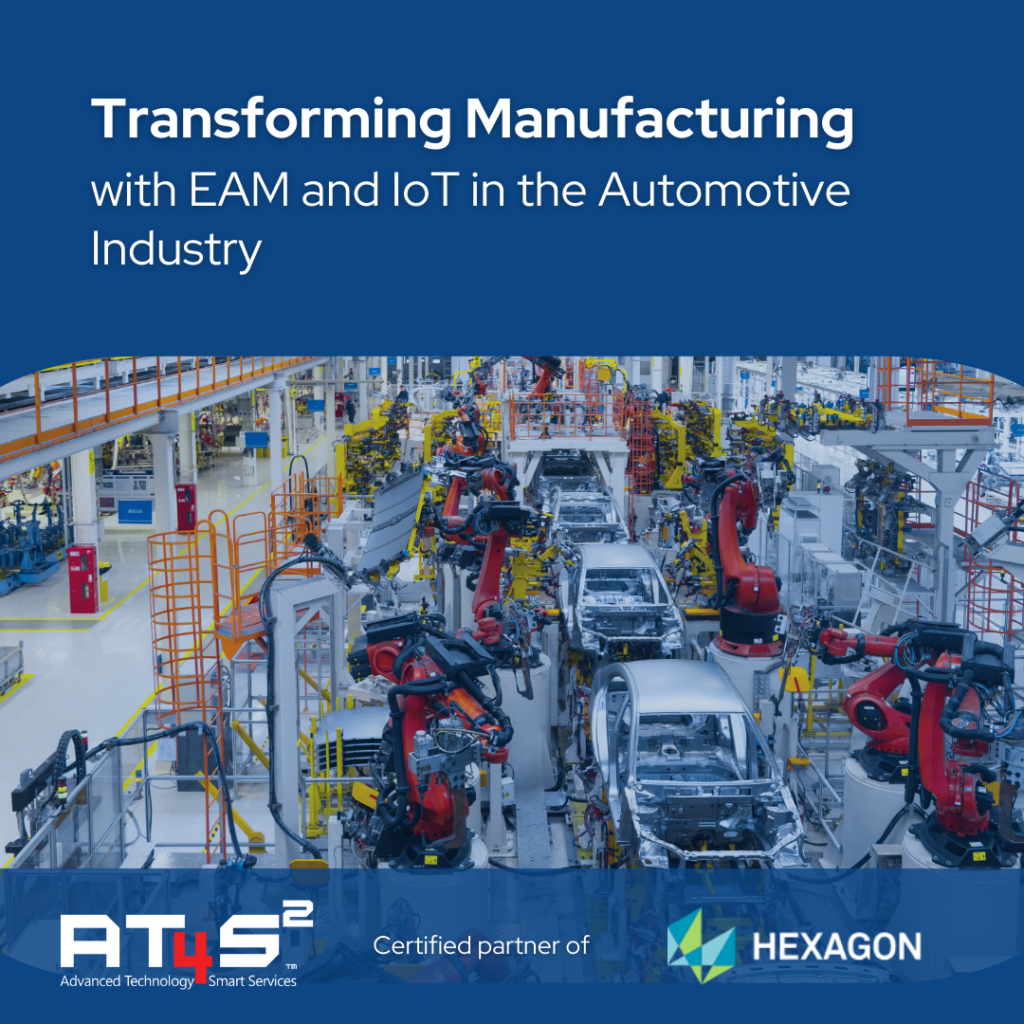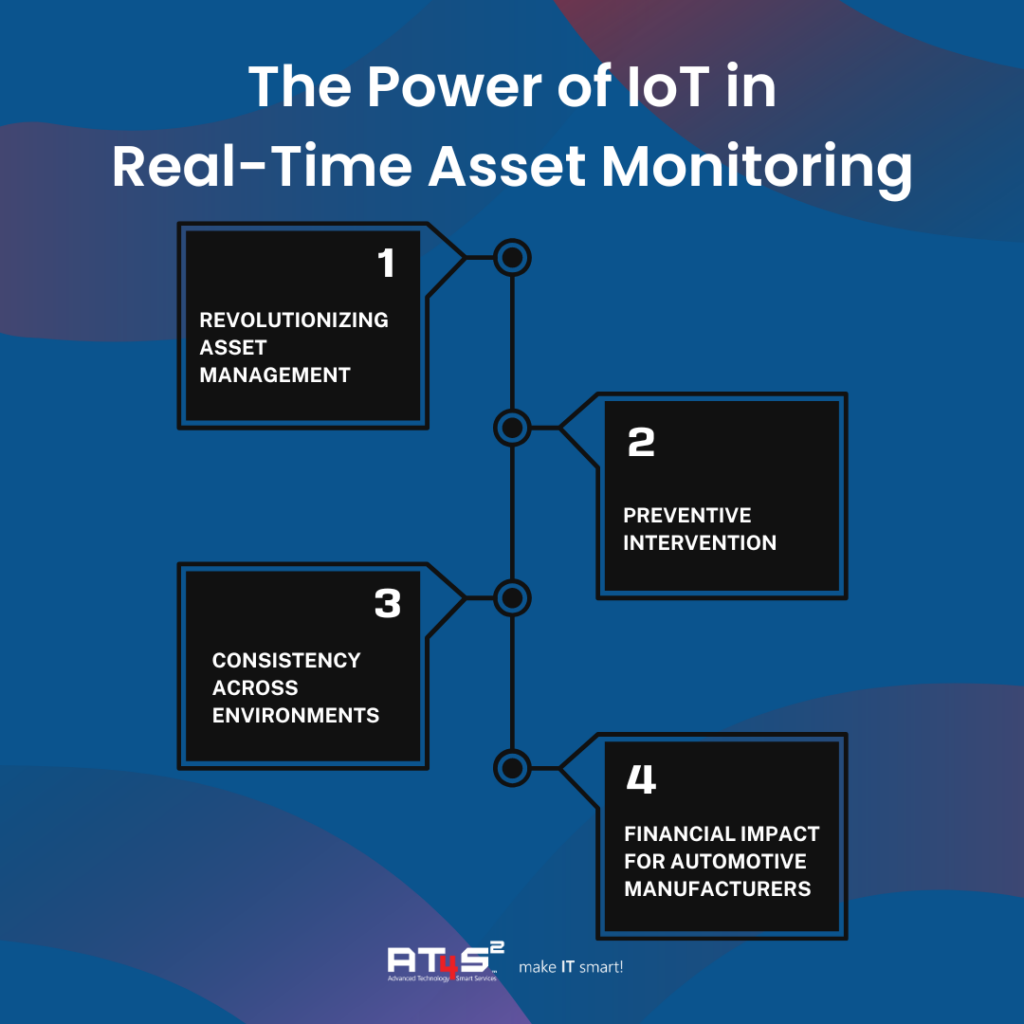Transforming Manufacturing with EAM and IoT in the Automotive Industry

17 April 2024
In automotive manufacturing, the integration of the Internet of Things (IoT) with Enterprise Asset Management (EAM) systems represents a transformative leap toward operational excellence.
This synergy can entirely enhance operational efficiency and upgrade real-time monitoring to exceptional levels, ensuring automotive factories are smarter, more responsive, and infinitely more capable of adapting to the demands of modern production environments. Let’s delve into the specifics below!
The Evolution of EAM in the Automotive Industry
Historically, Enterprise Asset Management has been the cornerstone of maintaining the quality and utilization of assets within the automotive sector.
EAM systems, exemplified by robust platforms like HxGN EAM, have guided clients towards improved asset maintenance, relying heavily on manual inputs and human oversight.
Maintenance schedulers and planners played pivotal roles in preempting outages and scheduling inspections to minimize downtime. However, despite meticulous preventive maintenance plans, asset downtime and the mean time to repair (MTTR) have remained challenging, impacting the overall quality and utilization of assets.
The Emergence of IoT and AI in Asset Management
The integration of IoT and AI technologies marks a significant evolution in the realm of asset management, particularly in the automotive manufacturing industry. IoT facilitates a direct connection between on-field equipment and IT systems, offering real-time insights into the health and performance of assets. This connection allows maintenance planners to not only observe but also anticipate the needs of the machinery, moving from a reactive maintenance model to one that is far more predictive and efficient.
The true innovation lies in how IoT transforms data into actionable insights. Sensors attached to equipment stream data on performance metrics, operational conditions, and potential fault indicators directly to cloud-based platforms.
Such data, when analyzed, empowers maintenance teams to schedule interventions precisely when needed, significantly reducing the MTTR and, by extension, enhancing overall asset utilization. The seamless nature of this data integration means that predictive maintenance is no longer a goal but a reality, fundamentally altering how assets are managed and maintained.
The Power of IoT in Real-Time Asset Monitoring
IoT’s capability for real-time monitoring is revolutionizing asset management within automotive factories. It’s not just about the constant flow of data; it’s about the quality and immediacy of the insights that this data provides. With IoT, factories gain a panoramic view of their operations, identifying issues before they escalate into costly downtimes.
This technology ensures consistency across environments by mirroring exact conditions from one setting to another, bridging the gap between different stages of the manufacturing process. The immediate benefit is a dramatic reduction in discrepancies and a lower chance of unexpected failures.
For automotive manufacturers, where even minor interruptions can lead to significant financial losses, the ability to preemptively address potential issues is invaluable. The adoption of IoT in real-time monitoring is not merely an upgrade; it’s a complete overhaul of traditional asset management practices.

AI and Machine Learning: Enabling Predictive Maintenance
Building upon the foundation provided by IoT, AI, and Machine Learning (ML) together introduce a new level of sophistication to asset maintenance.
These technologies analyze the comprehensive data collected by IoT devices can understand current asset conditions, but beyond that, it can also predict future performance and maintenance needs. This predictive capability allows for a proactive approach to maintenance, where actions are taken based on data-driven forecasts rather than reactive responses to failures.
AI models utilize historical maintenance records alongside real-time IoT data to identify patterns, predict potential downtimes, and recommend maintenance schedules. This approach saves significant costs associated with unplanned outages and also optimizes the maintenance process, ensuring that assets operate at their highest efficiency. Moreover, AI-driven predictive maintenance can adapt over time, learning from each interaction to refine its predictions and recommendations, thereby continually improving the maintenance process and asset performance.
The IoT-EAM Integration Journey
The path to integrating IoT with EAM systems, while promising a significant boost in operational efficiency, demands a strategic approach. Transitioning to a model that emphasizes data-driven, predictive maintenance isn’t straightforward—it necessitates meticulous planning and the deployment of advanced technological frameworks. Embracing new methodologies is also crucial, as it aligns traditional practices with the innovations brought by IoT. The challenges, though substantial, pale in comparison to the benefits: substantial cost reductions, minimized downtime, and superior asset utilization. For automotive manufacturers focused on maintaining a competitive edge, embarking on this integration journey is not just beneficial; it’s essential. It represents a commitment to leveraging technological advancements to refine operational processes and outcomes.
The Road Ahead for Automotive Factories
The future landscape for automotive factories is being reshaped by the integration of IoT with EAM systems. This pivotal move towards innovation is setting a new standard for operational efficiency and smart manufacturing. The promise of smarter factories – those that are fully equipped to confront both current challenges and future uncertainties – is at the heart of this technological integration. It signifies a shift towards operations that are not merely enduring the rapid pace of industry evolution but are flourishing within it.
By adopting IoT and EAM, automotive manufacturers are positioning themselves at the forefront of the digital transformation era. This strategic embrace of cutting-edge technologies ensures that their manufacturing processes are streamlined, resilient, and poised for future developments. The journey towards such operational sophistication is marked by a commitment to continuous improvement and adaptation, heralding a new era of manufacturing excellence and innovation.
Partner with AT4 Smart Services for Seamless Integration
For automotive manufacturers ready to embrace this transformation, partnering with AT4 Smart Services offers a gateway to integrating IoT with EAM systems seamlessly. With comprehensive services in implementing HxGN EAM and customizing integrations to meet unique enterprise needs, we are ready to guide automotive manufacturers through their digital journey. Whether optimizing existing systems or embarking on new implementations, AT4’s expertise ensures that your automotive factory harnesses the full potential of IoT and EAM for unparalleled operational efficiency.
The integration of IoT with EAM systems in automotive manufacturing is the future of industry excellence. As companies like AT4S2 lead the way in facilitating this integration, the path towards smarter, more efficient automotive factories becomes clearer, ensuring that the automotive industry continues to drive forward, powered by innovation and guided by insight.
